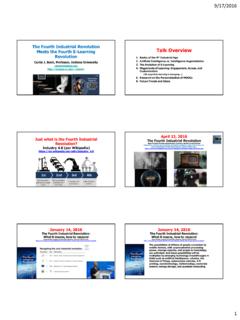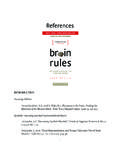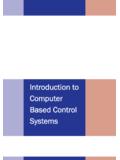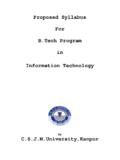Transcription of The impact of the fourth industrial revolution: a cross ...
1 Production, 28, e20180061, 2018 DOI: is an Open Access article distributed under the terms of the Creative Commons Attribution License, which permits unrestricted use, distribution, and reproduction in any medium, provided the original work is properly 1980-5411 (On-line version)1. IntroductionAccording to the Cambridge Dictionary (2017), the term industrial revolution is initially defined as: [..] the period of time during which work began to be done more by machines in factories than by hand at home.
2 The advances in science and technology have continuously supported the development of industrialization all around the world, and have helped to bring more specific and explicit meanings to this term over the years (Belvedere et al., 2013).Nowadays, even though there is still no universal agreement on what constitutes an industrial revolution (Maynard, 2015), four general phases have been identified from the perspective of the technological evolution (National Academy of Science and Engineering, 2013). The first industrial revolution is considered as one of the important advancements in humanity, which started by using water and steam-powered mechanical manufacturing facilities since the end of 18th century.
3 Later, at the start of 20th century, the application of electrically-powered mass production technologies, through the division of labour, was marked as the second industrial revolution . After that, to support further automation of manufacturing, the third industrial revolution began, around mid-1970s, by popularizing electronics and information technology (IT) in factories. In total, these three industrial revolutions took roughly two centuries to develop. In the past few years, along with the increased research attention on the Internet of Things (IoT) (Atzori et al.)
4 , 2010) and Cyber-Physical Systems The impact of the fourth industrial revolution : a cross -country/region comparisonYongxin Liaoa*, Eduardo Rocha Louresa, Fernando Deschampsa, Guilherme Brezinskia, Andr Ven ncioaaPontif cia Universidade Cat lica do Paran , Curitiba, PR, fourth industrial revolution stimulates the advances of science and technology, in which the Internet of Things (IoT) and its supporting technologies serve as backbones for Cyber-Physical Systems (CPS) and smart machines are used as the promoters to optimize production chains.
5 Such advancement goes beyond the organizational and territorial boundaries, comprising agility, intelligence, and networking. This scenario triggers governmental efforts that aim at defining guidelines and standards. The speed and complexity of the transition to the new digitalization era in a globalized environment, however, does not yet allow a common and coordinated understanding of the impacts of the actions undertaken in different countries and regions. The aim of this paper, therefore, is to bridge this gap through a systematic literature review that identifies the most influential public policies and evaluates their existing differences.
6 This cross -country/region comparison provides a worldwide panorama of public policies durations, main objectives, available funding, areas for action, focused manufacturing sectors, and prioritized technologies. Findings of this review can be used as the basis to analyse the position of a country against the existing challenges imposed towards its own industrial infrastructure and also to coordinate its public fourth industrial revolution . cross -country/region comparison. Systematic literature review.
7 Qualitative analysis. Quantitative to cite this article: Liao, Y., Loures, E. R., Deschamps, F., Brezinski, G., & Ven ncio, A. (2017). The impact of the fourth industrial revolution : a cross -country/region comparison. Production, 28, e20180061. DOI: Received: July 31, 2017; Accepted: Nov. 22, , 28, e20180061, 2018 | DOI: (CPS) (Khaitan & McCalley, 2015), industry, governments and society in general have noticed the trend towards the fourth industrial revolution and acted to benefit from what it could provide (Siemieniuch et al.)
8 , 2015). Moreover, according to a previous work (Liao et al., 2017), the number of conferences and academic papers related to Industrie (one significant research effort within the fourth industrial revolution era) have gradually increased, from 2013 to 2015, by times and times at the growing interest in the fourth industrial revolution all around the world, a question arises: what impact does the fourth industrial revolution bring to different countries and regions? This paper tries to answer this question by analysing academic contributions, based on systematic literature review methods presented by Nightingale (2009) and Pickering & Byrne (2014).
9 More specifically, two research sub-questions are listed as follows: Q1. What are the most influential public policies related to the fourth industrial revolution ? Q2. What are the similarities and differences between these public policies?The remaining sections of this paper are organized as follows: Section 2 presents the applied systematic literature review method and illustrates the data of interest. Based on these data, Section 3 characterizes the impact of the fourth industrial revolution through the qualitative and quantitative analysis of collected data related to each research sub-question.
10 After that, a discussion of those findings is given in Section 4. Finally, Section 5 concludes this paper and points out future Systematic literature review methodsBased on the Preferred Reporting Items for Systematic review and Meta-Analysis (PRISMA) flow chart (Moher et al., 2009), Figure 1 presents the different stages of the systematic literature review undertaken in this 1. Systematic literature review stages adopted in this general, the first round of review (Stages 1, 2 and 3) takes the 99 papers retrieved from Scopus (n0 in Figure 1) as its input, removes 2 duplicated papers in Stage 2, excludes 8 papers without full-text in Stage 3, and results in 89 papers (n1 in Figure 1).

















